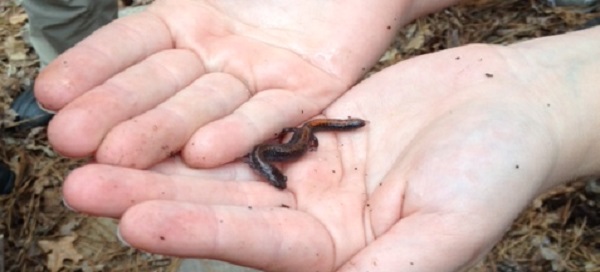
Photo by Charlene Wu
A few weeks ago, I was trooping through some local woods on the look-out for herpetofauna (snakes, lizards, salamanders, and frogs) for my graduate Wildlife Surveys course. As part of our search, we would carefully lift up wooden boards and tin pieces in the hopes that creatures would be hiding underneath. We had lifted quite a few boards unsuccessfully when suddenly, after the most recent lifting, a small, red-backed salamander appeared between the leaves!
After dousing her hand with water, one of my classmates carefully and gingerly picked up the little guy, holding it so the rest of us could take photos and scribble some quick notes. The salamander was small, maybe the size of my pointer finger, with tiny toes and a reddish sheen for which it earned its name. Though they are some of the tiniest creatures in the woods – barring insects – I never knew that they are some of the most important drivers of the forest ecosystem, and could even have major impacts on climate change itself.
Salamanders may be small, but they have big appetites. “On an average day,” writes Richard Conniff in a New York Times article, “a salamander eats 20 ants of all sizes, two fly or beetle larvae, one adult beetle, and half of an insect called the springtail.” Not bad for an amphibian weighing in at under an ounce!
These prey insects all have one thing in common, they are “shedding invertebrates,” or “bugs that spend their lives ripping leaves to little bits and eating them.” In the process, carbon and methane are released into the atmosphere – both principal drivers of global warming. By contrast, if the leaves remain uneaten, they are eventually covered by other leaves, and the carbon is captured by the soil instead of released into the atmosphere.
Okay, this may be true, but could salamanders really make a difference in large global cycles? Results from a new study demonstrate the very real impacts woodland salamanders make in forests all over the world. This study, undertaken in northwestern California, showed that when salamanders were removed from test plots, the insect shredders “consumed about 13 percent more of the leaf litter.” Half of the additional weight of leaves consumed “was carbon, released into the atmosphere,” and thus a significant source of greenhouse gases.
When salamanders were present at the plots in California, they sent an average of “179 pounds of carbon per acre of forest down into the soil, rather than up into the atmosphere.” That’s a lot of carbon when you multiply it over the millions of acres of forest across the United States. While other researchers disagree over the salamanders’ level of worldwide impact, all agree that they are very important elements of woodland ecosystem and food webs.
Unfortunately, salamanders may already be feeling the negative effects of climate change. They have been steadily losing size and abundance since the 1980s, and are even disappearing altogether. It’s possible that salamanders “are becoming even smaller as a way to adapt to warmer weather and reduced rainfall,” but whatever the cause, their complete disappearance would have very negative consequences.
When I walk in the forest nowadays, I may scan the treetops for birds, but I also keep in mind the many salamanders that are satisfying their gargantuan appetites unseen on the forest floor. They may be small, but they are perhaps one of the most critical elements of the forests we know and love.
Note: If you turn over logs or rocks to look at salamanders, make sure to replace them exactly as you found them. If you do pick them up, it is critical you wet your hands first, as your skin will dry them out.
